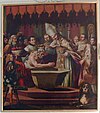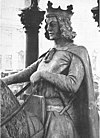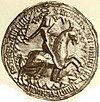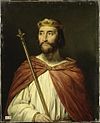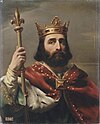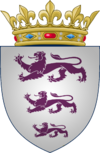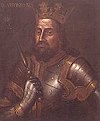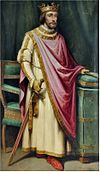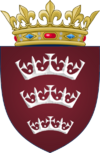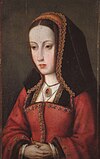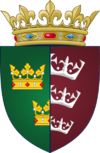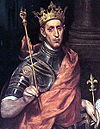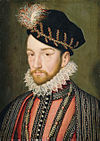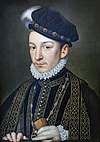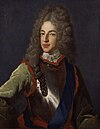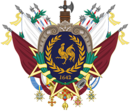Monarchy of Midrasia: Difference between revisions
No edit summary |
mNo edit summary |
||
| Line 19: | Line 19: | ||
The '''Monarchy of Midrasia''' was the monarchy of [[Midrasia]], its dependencies and overseas territories until its abolition in 1642. The monarchy was also a {{wp|popular monarchy|popular}} and {{wp|hereditary monarchy|hereditary}} position whose incumbent is styled the ''King'' or ''Queen of the Mydra'' (Midrasian:''Roi/Reine des Mydra''). The monarch served as the country's {{wp|head-of-state}} and had considerable political power, allowing them to act in an absolute manner without the consent of parliament. | The '''Monarchy of Midrasia''' was the monarchy of [[Midrasia]], its dependencies and overseas territories until its abolition in 1642. The monarchy was also a {{wp|popular monarchy|popular}} and {{wp|hereditary monarchy|hereditary}} position whose incumbent is styled the ''King'' or ''Queen of the Mydra'' (Midrasian:''Roi/Reine des Mydra''). The monarch served as the country's {{wp|head-of-state}} and had considerable political power, allowing them to act in an absolute manner without the consent of parliament. | ||
Officially, the last monarch to sit the Midrasian throne was Henry V in 1642, though the short reign of Charles IV in 1871 is disputed. Since the end of the Midrasian Civil War in 1648 the royal family has resided in exile in [[ | Officially, the last monarch to sit the Midrasian throne was Henry V in 1642, though the short reign of Charles IV in 1871 is disputed. Since the end of the Midrasian Civil War in 1648 the royal family has resided in exile in [[Atresca]]. In recent times however, the Head of the Midrasian royal family has taken to disavowing their claims to the Midrasian throne, allowing them to officially enter the country. | ||
The current head of the royal household is [[Eleanor, Duchess of Giozzara]], who acceded to the position following the death of her grandfather, Louis of Giozzara, on 20 July 2017. | The current head of the royal household is [[Eleanor, Duchess of Giozzara]], who acceded to the position following the death of her grandfather, Louis of Giozzara, on 20 July 2017. | ||
| Line 206: | Line 206: | ||
====House of Albons (1179–1227)==== | ====House of Albons (1179–1227)==== | ||
Following the death of Francis III, the throne of Midrasia passed to the House of Albons, the next dynastic branch with the strongest claim to the throne. Only two generations of the House of Albons would rule Midrasia, with Queen Emily as Henry's only heir, the Queen's marriage to an | Following the death of Francis III, the throne of Midrasia passed to the House of Albons, the next dynastic branch with the strongest claim to the throne. Only two generations of the House of Albons would rule Midrasia, with Queen Emily as Henry's only heir, the Queen's marriage to an Atrescan noble Maurice Annabaldi would see the Kingdom pass from the Toussaint dynasty. | ||
{| width=95% class="wikitable" | {| width=95% class="wikitable" | ||
! width=8% | Portrait | ! width=8% | Portrait | ||
| Line 234: | Line 234: | ||
===Annabaldi dynasty (1227–1408)=== | ===Annabaldi dynasty (1227–1408)=== | ||
The Annabaldi dynasty were rulers of San Fausto since 1187. Through the marriage of Queen Emily to the cousin of an | The Annabaldi dynasty were rulers of San Fausto since 1187. Through the marriage of Queen Emily to the cousin of an Atrescan Duke, a cadet branch of the Atrescan ducal family came to rule over the Kingdoms of Toussaint and Mydroll. The Annabaldi dynasty would rule the Kingdom from 1227 to 1408 and would oversee the unification of the Kingdom of Midrasia in 1309. | ||
{| width=95% class="wikitable" | {| width=95% class="wikitable" | ||
! width=8% | Portrait | ! width=8% | Portrait | ||
| Line 301: | Line 301: | ||
|} | |} | ||
====Disputed claimants==== | ====Disputed claimants==== | ||
Upon the death of the childless Queen Eliane, the throne of Midrasia was claimed by Matteo, King of | Upon the death of the childless Queen Eliane, the throne of Midrasia was claimed by Matteo, King of Atresca on the grounds of being the head of the House of Annabaldi and thereby rightful successor based on Atrescan succession law. This claim was disputed by the Midrasian nobility on the grounds of Atrescan Salic Law only allowing inheritance through male lineage. The nobility elected Philip II of the House of Eurical as King of Midrasia following the death of Eliane. | ||
{| width=95% class="wikitable" | {| width=95% class="wikitable" | ||
! width=8% | Portrait | ! width=8% | Portrait | ||
| Line 311: | Line 311: | ||
! width=10% | Title | ! width=10% | Title | ||
|- | |- | ||
|bgcolor="#FBDDBD" align="center"|[[File:CharlesIIIofSaboy-byJeanClouet.jpg|100px]]||bgcolor="#FBDDBD" align="center"|[[image:Aquideetmydrazia.png|100px]]||bgcolor="#FBDDBD" align="center"|Matteo I of | |bgcolor="#FBDDBD" align="center"|[[File:CharlesIIIofSaboy-byJeanClouet.jpg|100px]]||bgcolor="#FBDDBD" align="center"|[[image:Aquideetmydrazia.png|100px]]||bgcolor="#FBDDBD" align="center"|Matteo I of Atresca <br><small>(Mattieu Ier d'Atresca)</small> ||bgcolor="#FBDDBD" align="center"|6 August 1408||bgcolor="#FBDDBD" align="center"|12 September 1415||bgcolor="#FBDDBD"| By right of his position as head of the House of Annabaldi following the death of Eliane of Midrasia||bgcolor="#FBDDBD" align="center"|King of the Mydra<br><small>(Roi des Mydra)</small> | ||
|} | |} | ||
| Line 317: | Line 317: | ||
The '''Toussaint dynasty''' were restored following the death of the childless and unmarried Queen Eliane. The nobility had elected Philip of Eurical a descendant of Toussaint as the next Midrasian King, however his elevation was disputed by the Duke of Lucania, Matteo I. The resulting succession war would spark the seven year long Lombard War between the two Kingdoms. | The '''Toussaint dynasty''' were restored following the death of the childless and unmarried Queen Eliane. The nobility had elected Philip of Eurical a descendant of Toussaint as the next Midrasian King, however his elevation was disputed by the Duke of Lucania, Matteo I. The resulting succession war would spark the seven year long Lombard War between the two Kingdoms. | ||
====House of Eurical (1408–1642)==== | ====House of Eurical (1408–1642)==== | ||
Whilst the House of Eurical acceded to the throne in 1408, its claim was disputed by the Mardimon nobility. Following a Midrasian victory in the Lombard War, the Mardimons dropped their claim and Philip II was confirmed as Midrasian King. Under the House of Eurical Midrasia would reach the zenith of its power within the early modern period, expanding overseas and becoming a foremost military power. However, under the House of Eurical the [[Midrasian Civil War]] would take place as Henry V ousted the boy King Louis VII and would in turn be removed himself, leading to the abolition of the Midrasian monarchy. Despite this, the royal house would flee first to [[Vaellenia]] and then to [[ | Whilst the House of Eurical acceded to the throne in 1408, its claim was disputed by the Mardimon nobility. Following a Midrasian victory in the Lombard War, the Mardimons dropped their claim and Philip II was confirmed as Midrasian King. Under the House of Eurical Midrasia would reach the zenith of its power within the early modern period, expanding overseas and becoming a foremost military power. However, under the House of Eurical the [[Midrasian Civil War]] would take place as Henry V ousted the boy King Louis VII and would in turn be removed himself, leading to the abolition of the Midrasian monarchy. Despite this, the royal house would flee first to [[Vaellenia]] and then to [[Atresca]]. Following the death of Hugh of Eurical on the battlefield, the House of Valperge came to head the Midrasian royal household. The House of Valperge was a cadet branch of the Toussaint dynasty descended from Charles I. The House of Valperge would live out its time in-exile in Atresca and would never set foot on Midrasian soil. Despite this, the household would remain a wealthy and politically powerful body within the Atrescan kingdom. The House of Valperge ultimately died off following the death of the childless Hugh Valperge, leaving the household to pass into the House of Detudiém which remains the head of the Toussaint branch of the royal household to this day. | ||
{| width=95% class="wikitable" | {| width=95% class="wikitable" | ||
! width=8% | Portrait | ! width=8% | Portrait | ||
| Line 453: | Line 453: | ||
===House of Detudiém (1871)=== | ===House of Detudiém (1871)=== | ||
The House of Detudiém came to head the Midrasian royal household following the demise of the House of Valperge. The House was formed by Philip of Giozzara, second cousin to Hugh Valperge. Whilst much of the House of Detudiém spent their time in-exile in | The House of Detudiém came to head the Midrasian royal household following the demise of the House of Valperge. The House was formed by Philip of Giozzara, second cousin to Hugh Valperge. Whilst much of the House of Detudiém spent their time in-exile in Atresca, during the crisis of the early 1870s, Royalists launched a coup against the republican government, installing Charles IV as king. Despite this, Charles was forced to resign his title around 5 months later as the republican government retook control of the capital. The House of Detudiém remains in exile to this day, although in recent years members of the household have taken to renouncing their claim to the Midrasian throne, allowing them to enter the country. The current pretender to the throne from the House of Detudiém is [[Eleanor, Duchess of Giozzara]], however she has renounced her claim to the Midrasian throne. | ||
{| width=95% class="wikitable" | {| width=95% class="wikitable" | ||
! width=8% | Portrait | ! width=8% | Portrait | ||
Latest revision as of 12:27, 29 February 2020
| Monarchy of Midrasia | |
|---|---|
 Royal Coat of Arms | |
 Henry V | |
| Details | |
| Style | His/Her Majesty |
| First monarch | Toussaint |
| Last monarch | Henry V Charles IV (disputed) |
| Formation | 891 |
| Abolition | 23 September 1642 |
| Residence | Palais de Roixs Palais d'Autun Chateau Thierry Palazzo Mydrazia |
| Appointer | Hereditary |
| Pretender(s) | Eleanor, Duchess of Giozzara Louis Devreux |
The Monarchy of Midrasia was the monarchy of Midrasia, its dependencies and overseas territories until its abolition in 1642. The monarchy was also a popular and hereditary position whose incumbent is styled the King or Queen of the Mydra (Midrasian:Roi/Reine des Mydra). The monarch served as the country's head-of-state and had considerable political power, allowing them to act in an absolute manner without the consent of parliament.
Officially, the last monarch to sit the Midrasian throne was Henry V in 1642, though the short reign of Charles IV in 1871 is disputed. Since the end of the Midrasian Civil War in 1648 the royal family has resided in exile in Atresca. In recent times however, the Head of the Midrasian royal family has taken to disavowing their claims to the Midrasian throne, allowing them to officially enter the country.
The current head of the royal household is Eleanor, Duchess of Giozzara, who acceded to the position following the death of her grandfather, Louis of Giozzara, on 20 July 2017.
The Midrasian monarchy had its origins in the various Kingdoms referred to as the Mydran Realms which dominated the area of modern Midrasia following the fall of the Fiorentine Empire. The modern Midrasian royal house traces its ancestry back to the rulers of the Kingdom of Toussaint which eventually went on to form the Kingdom of Midrasia. The Midrasian monarchy ruled consecutively for 733 years until the Midrasian Civil War where it was abolished and a republican system of government under the Consul implemented.
Historical role
Historically the Midrasian monarchs served as the country's head of state and the lead representative of the Alydian Church in Midrasia (although this authority is usually handed to the Midrasian Cardinal by convention). Furthermore, the Midrasian monarch was also expected to lead their troops into battle, acting as commander-in-chief of the armed forces. All Midrasian monarchs at some point led their troops on the battlefield until the abolition of the monarchy. For much of their history, the Midrasian royal family operated as an absolute monarchy, able to act independently of the Midrasian nobility and enforce its will upon the country and their subjects. Nevertheless, a representative assembly did exist known as the Estates General, wherein the three estates of the Kingdom, the Nobility, Clergy and Commons would be represented. This body would only be called when the monarch deemed it necessary, and even then mostly only during times of crisis. Another body, known as the Noble Assembly also existed. This was mostly an informal body or gathering of the nobility to advise the monarch on matters of state and foreign affairs or remonstrate against their actions. This body would only be called sporadically however, with several monarch selecting to call the assembly more often than others. A major contributing factor in the outbreak of the Civil War was Henry V's refusal to call the body, whereas his predecessors relied heavily on the Noble Assembly to legitimise their actions.
Succession
Succession to the throne of Midrasia operated based on Absolute primogeniture in which sex is irrelevant for inheritance. This has been the case since 1995 when family decided to shift away from the system of male-preference primogeniture which had been in operation since the first rulers of Toussaint. Following the death of Louis of Giozzara's heir and grandson Napoleone in 2017, Princess Eleanor became the de-jure heir of the Midrasian royal house. The current heir apparent is Henri, Duke of Piemonte, uncle to the sitting head Eleanor.
Historically, the heir apparent to the Midrasian throne was usually styled the 'Prince of Alpiens' (Príncep d'Alpiens) in reference to the Principality of Alpiens (modern day Vaellenia), which has been a part of Midrasia since mid-Seventeenth Century.
List of monarchs
Toussaint dynasty (891–1227)
The Toussaint dynasty refers to the rulers of the rulers of western Midrasia after the conversion of King Toussaint to the Alydian faith in the year 891. The Toussaint dynasty were descended from the burgundian and langobardic kings who ruled over the Midrasian region following the fall of the Fiorentine Empire in the mid 5th century. The region they ruled was henceforth referred to as the Kingdom of Toussaint and covered the modern regions of Toussaint, Lotrič and portions of Viure, Catougne and Veleaz. The Toussaint dynasty and its various branches ruled over the Kingdom of Toussaint until it passed outside of the family in 1227, however would reclaim the throne under the House of Eurical in 1408.
Direct Toussantians (891–964)
The direct Toussantians refers to the rule of Toussaint and his direct descendants from 891 until the lines extinction in 984. The rule of the direct branch of the Toussaint dynasty is split into two phases by the Succession Crisis of 964–966.
House of Lereff (964–966)
The House of Lereff was branch of Toussaint dynasty, descended from John, second son of Clovis I. Following the death of all of Clovis' sons a succession crisis developed, with Clovis II, grandson to the old King being crowned in 962. In rebellion against the King and supported by a number of nobles, Francis was crowned King of Toussaint in 964 and successfully ousted Clovis II in 964, ruling the Kingdom for two years before he himself was deposed and executed.
Direct Toussantians (966–984)
The execution of Francis I saw the conclusion of the succession crisis, with Clovis II regaining the throne in 966. The direct descendants of King Toussaint would rule the Kingdom until 984. With the death of Clovis III, the Kingdom would pass to the son of Francis I who was spared following the succession crisis.
House of Lereff (984–1179)
The House of Lereff returned to the throne in 984 following the death of the childless Clovis III. Initially there was much opposition to the accession of Francis II to the throne due to his father's role in the Succession Crisis of 964–966. Despite being pardoned by Clovis II, Francis II chose to confirm his legitimacy by marrying Maria Leronde, a descendant of King Toussaint who formed part of the House of Albon. Under the House of Lereff Toussaint would join in a union with the Kingdom of Mydroll, uniting much of western Midrasia in the process. The House of Lereff would rule Toussaint until its demise in 1179.
House of Albons (1179–1227)
Following the death of Francis III, the throne of Midrasia passed to the House of Albons, the next dynastic branch with the strongest claim to the throne. Only two generations of the House of Albons would rule Midrasia, with Queen Emily as Henry's only heir, the Queen's marriage to an Atrescan noble Maurice Annabaldi would see the Kingdom pass from the Toussaint dynasty.
Annabaldi dynasty (1227–1408)
The Annabaldi dynasty were rulers of San Fausto since 1187. Through the marriage of Queen Emily to the cousin of an Atrescan Duke, a cadet branch of the Atrescan ducal family came to rule over the Kingdoms of Toussaint and Mydroll. The Annabaldi dynasty would rule the Kingdom from 1227 to 1408 and would oversee the unification of the Kingdom of Midrasia in 1309.
Disputed claimants
Upon the death of the childless Queen Eliane, the throne of Midrasia was claimed by Matteo, King of Atresca on the grounds of being the head of the House of Annabaldi and thereby rightful successor based on Atrescan succession law. This claim was disputed by the Midrasian nobility on the grounds of Atrescan Salic Law only allowing inheritance through male lineage. The nobility elected Philip II of the House of Eurical as King of Midrasia following the death of Eliane.
Toussaint dynasty (1408–present)
The Toussaint dynasty were restored following the death of the childless and unmarried Queen Eliane. The nobility had elected Philip of Eurical a descendant of Toussaint as the next Midrasian King, however his elevation was disputed by the Duke of Lucania, Matteo I. The resulting succession war would spark the seven year long Lombard War between the two Kingdoms.
House of Eurical (1408–1642)
Whilst the House of Eurical acceded to the throne in 1408, its claim was disputed by the Mardimon nobility. Following a Midrasian victory in the Lombard War, the Mardimons dropped their claim and Philip II was confirmed as Midrasian King. Under the House of Eurical Midrasia would reach the zenith of its power within the early modern period, expanding overseas and becoming a foremost military power. However, under the House of Eurical the Midrasian Civil War would take place as Henry V ousted the boy King Louis VII and would in turn be removed himself, leading to the abolition of the Midrasian monarchy. Despite this, the royal house would flee first to Vaellenia and then to Atresca. Following the death of Hugh of Eurical on the battlefield, the House of Valperge came to head the Midrasian royal household. The House of Valperge was a cadet branch of the Toussaint dynasty descended from Charles I. The House of Valperge would live out its time in-exile in Atresca and would never set foot on Midrasian soil. Despite this, the household would remain a wealthy and politically powerful body within the Atrescan kingdom. The House of Valperge ultimately died off following the death of the childless Hugh Valperge, leaving the household to pass into the House of Detudiém which remains the head of the Toussaint branch of the royal household to this day.
House of Devreux (1784-1791)
The House of Devreux, known for their role as Protecteur and Consul following the Midrasian Civil War also attempted to style themselves in a monarchical fashion under the auspices of Jean-Jacques Devreux who changed his name to Cesare. Devreux styled himself as Emperor of the Mydra during the Midrasian Revolution, a title disputed by parliament and the royal household in-exile. The Devreux family was forced to relinquish the title as part of the settlement of 1791, however a number of Devreuxan supporters continue to view the Devreux family as the legitimate heirs to the Midrasian throne.
House of Detudiém (1871)
The House of Detudiém came to head the Midrasian royal household following the demise of the House of Valperge. The House was formed by Philip of Giozzara, second cousin to Hugh Valperge. Whilst much of the House of Detudiém spent their time in-exile in Atresca, during the crisis of the early 1870s, Royalists launched a coup against the republican government, installing Charles IV as king. Despite this, Charles was forced to resign his title around 5 months later as the republican government retook control of the capital. The House of Detudiém remains in exile to this day, although in recent years members of the household have taken to renouncing their claim to the Midrasian throne, allowing them to enter the country. The current pretender to the throne from the House of Detudiém is Eleanor, Duchess of Giozzara, however she has renounced her claim to the Midrasian throne.
| Portrait | Coat of arms | Name | Monarch from | Monarch until | Claim | Title |
|---|---|---|---|---|---|---|

|

|
Charles IV | 4 May 1871 | 12 September 1871 | • Grandson of Eleanor, Duchess of Giozzara | King of the Mydra (Roi des Mydra) |
Current pretenders
Current pretenders to the Midrasian throne exist in both the Toussaint and Devreux households. There are currently two claimants to the Midrasian royal throne:
- Eleanor, Duchess of Giozzara of the Toussaint Royal Household
- Louis Devreux of the Imperial Devreux Household
